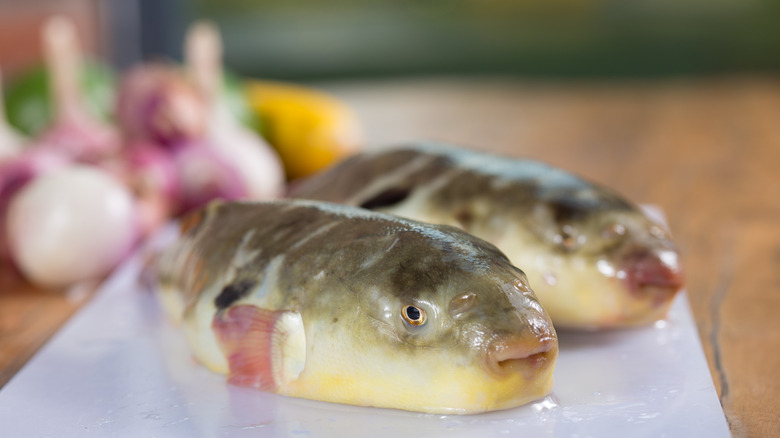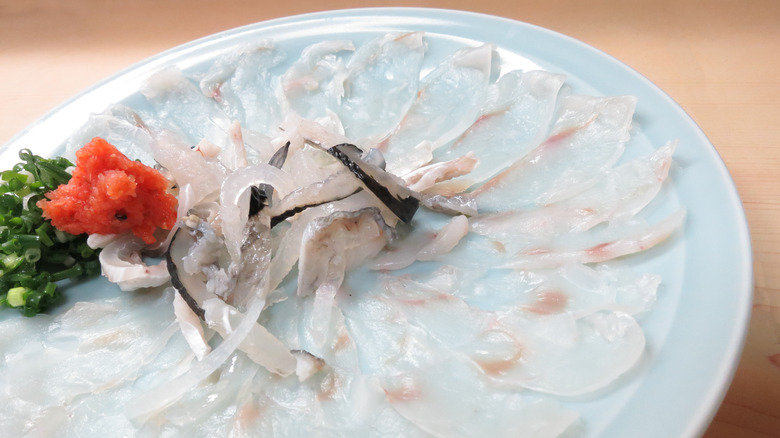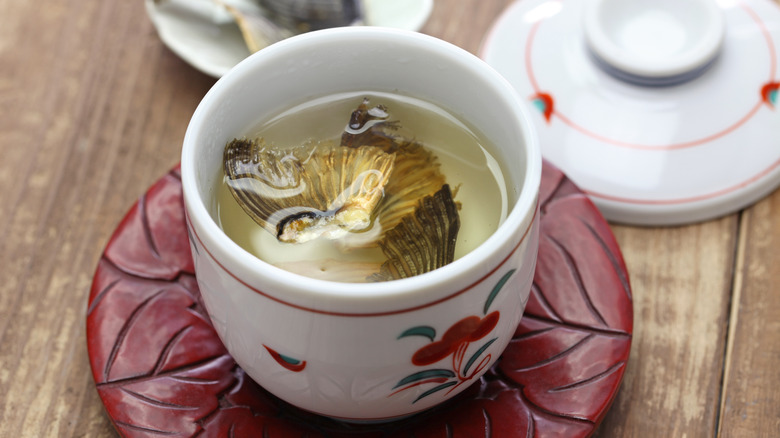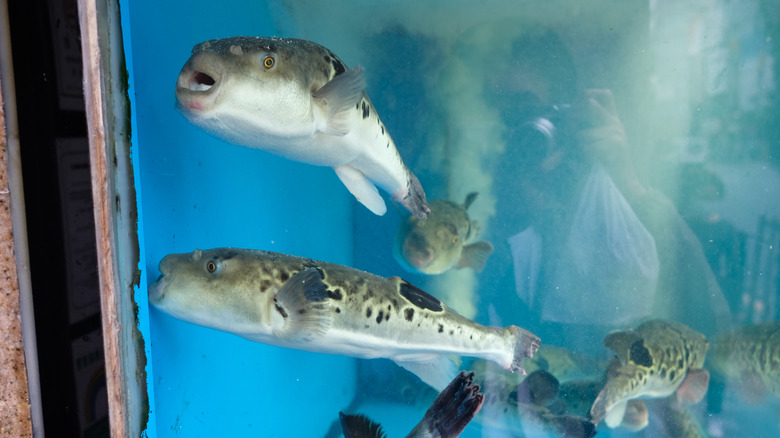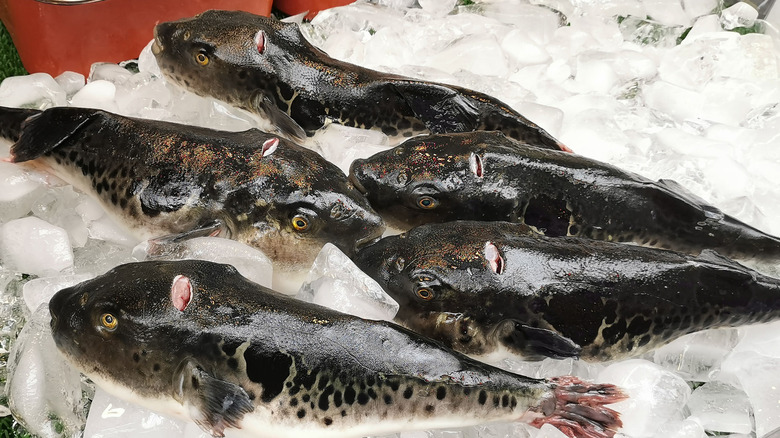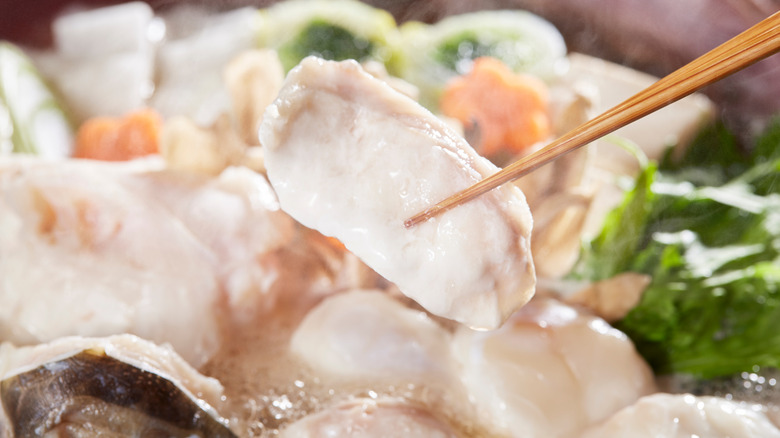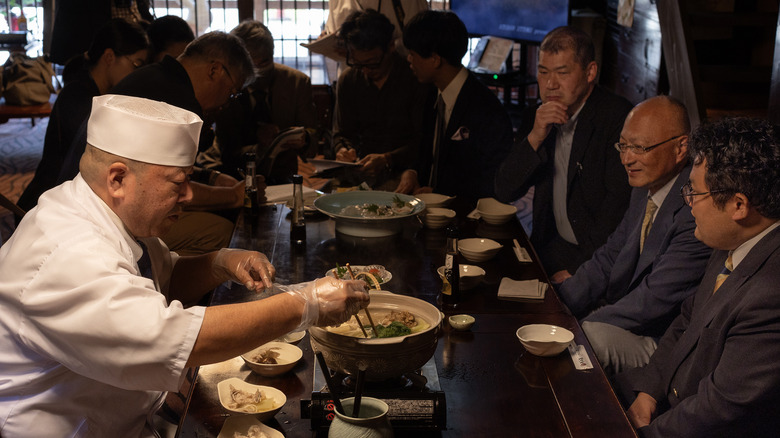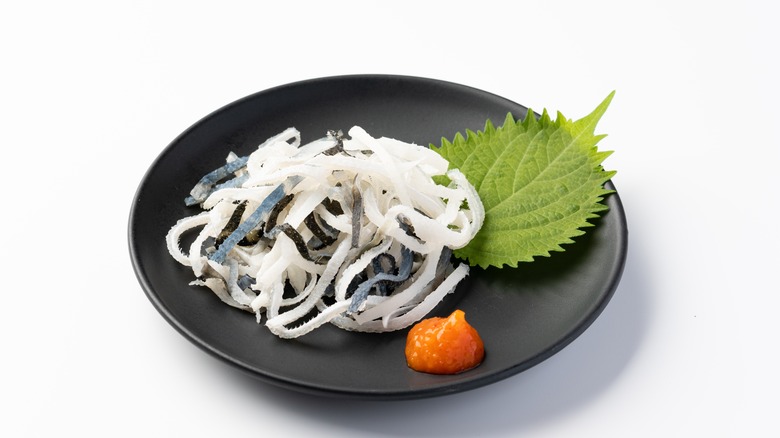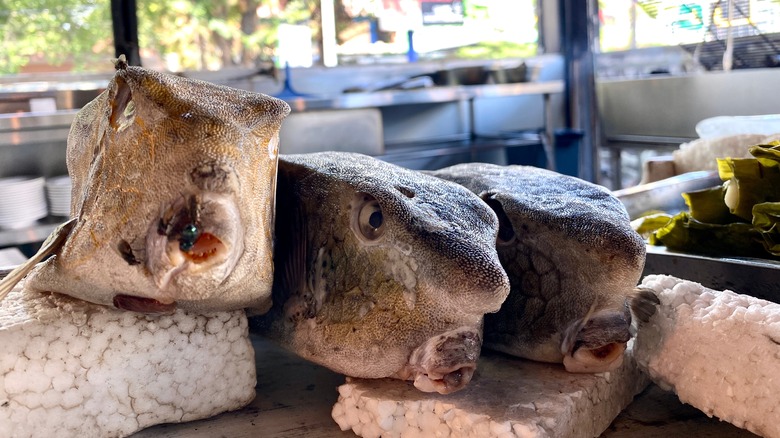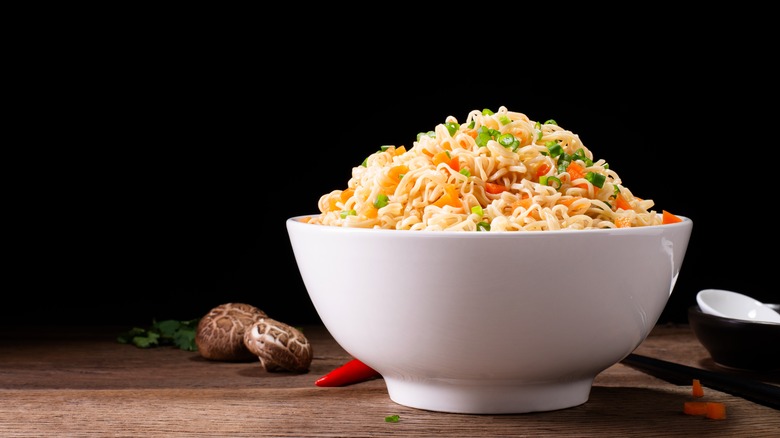How The Poisonous Pufferfish Became A Delicacy (And The Deadly Mishaps That Followed)
Pufferfish are so unusual and pudgy-looking that they almost seem cute. But this animal didn't survive for eons in such an unforgiving environment as the ocean because it's fun to look at. First of all, that pudginess is what allows pufferfish to inflate, which is a defense mechanism meant to deter predators by suddenly increasing in size — a trick accomplished by swallowing a bunch of water all at once.
Then let's not forget that some types of pufferfish also have menacing spikes. But what truly makes this creature a scourge of the seas is its potent toxicity. Many species of pufferfish contain tetrodotoxin, a powerful neurotoxin that can be lethal to humans, even in tiny quantities.
Despite this danger, pufferfish holds a special place in the cuisine of Japan, where it's known as fugu. Considered a delicacy, fugu is revered for its delicate flavor and the meticulous skill required to serve it safely. The preparation of fugu is strictly regulated by Japanese law, necessitating that chefs undergo extensive training and obtain a special license to ensure they can remove toxic parts of the fish properly. Even so, the possibility of ingesting the deadly toxin when consuming this fish is always present, and no doubt lingers in the back of the mind of anyone brave enough to sample it. But that trepidation partly comes from the mystery surrounding this fish, so let's take a look at background information that can help dispel some of that fear.
Pufferfish has been eaten for centuries
Throughout human history, we've learned about the dangers of poisonous food through trial and tragic error. If someone ate a plant or animal and it didn't kill them, it might be welcomed into subsequent meals as food. If it killed them, the failed food was typically discarded and shunned.
But somehow, that didn't happen with pufferfish, which has been feeding — and frequently killing — Japanese diners since 1000 B.C. or earlier, as we know from pufferfish bones that have been unearthed by archaeologists in Japan. At that time, fugu was probably not seen as the luxury item it is today — it most likely remained on the menu out of necessity, due to a scarcity of other less-deadly options.
Despite an attempt to ban the food in the 16th century, due to all those aforementioned deaths, the fish remained popular among all social strata. Thus the ban was lifted over 200 years later after a prime minister tried fugu and fell in love with it. It was around this time that fugu started to become more widely enjoyed. But if you think about it, all this shouldn't be so surprising: Various types of mushrooms can kill us at the drop of a hat, yet we continue to consume them in large quantities and with little to no concern for our survival.
Fugu can be prepared in various ways
Fugu must be prepared in a very specific way in order to be safe for consumption. Its toxic parts — which can be found in different parts of the fish depending on the species, including in the liver and ovaries — need to be carefully removed. But after that surgical procedure is accomplished, the fish can be made with different accompanying ingredients and various techniques.
One popular way to eat pufferfish is as sashimi, whereby the raw fish is sliced extremely thinly, to the point where it is largely transparent, and served with a citrus dressing or ponzu sauce made with rice wine, soy sauce, and citrus juice. This also allows the chef to delicately fashion the fish into dainty shapes for a spectacular presentation on the plate.
Fugu can also be served cooked, like in a hot pot. In this iteration, the fish is simmered with vegetables and served with rice. And the options don't stop there. Frying and grilling are also ways of preparing fugu, and the latter technique is especially popular when done over a charcoal grill. In what was likely the result of a wild fit of creativity, someone once added fugu fins to sake — and the drink, known as hirezake, remains popular ever since.
It contains a deadly toxin
The toxin in pufferfish is no joke. It's not like the trace amounts of cyanide in apple seeds, which cannot harm, let alone kill, a fully grown human — or even a little human, for that matter. The tetrodotoxin in pufferfish (aka TTX) — is another story. Within a few hours of ingesting even a small amount of TTX, an unwitting diner can experience nausea, paralysis, and heart failure, leading to near-certain death, as there is no known antidote.
A single pufferfish contains enough TTX to kill 30 people, and when fugu is prepared incorrectly, that poison can get into your bloodstream. In other words, making a mistake when cooking pufferfish can be deadly. Even disposing the toxic parts of the fish must be done carefully, and in Japan this requires chefs to place the poisonous organs in designated containers, which are then carried off to be burned as a biohazard.
Pufferfish is very expensive
Despite the potential dangers of consuming pufferfish, this delicacy is very expensive. This may seem especially surprising given that fugu is widely described as being relatively flavorless, although it tends to have a pleasing texture that is firm yet silky, especially when served as sashimi.
Tiger pufferfish, or torafugu, is one of the most expensive fugu varieties, and also among the most toxic. This pricing may also be due to overfishing of such desirable pufferfish. While this species is not considered threatened or endangered, the Japanese government has imposed fishing limits on wild tiger pufferfish in 2005. Farmed pufferfish is also available and less expensive, but fugu aficionados claim that it's not as good as the wild fish.
At the end of the day, the high price might be a good thing. Given how deadly this fish can be, you're going to want to eat it at a restaurant where you can be sure the chef has been properly trained and is well paid, and know that the fish has been sourced according to Japan's strict regulations.
Restaurants need a special license to serve pufferfish
If you're interested in heading to Japan to try fugu — either out of curiosity, because you're a daredevil, or if you're aiming to enjoy the full variety of Japanese dishes — know that not just any restaurant will serve it to you prepared from scratch. Establishments have to have a designated license to offer the delicacy fresh, and follow strict rules that include hiring a chef with special training.
This wasn't always the case. Licenses only started to be a requirement in 1948, which helped lead to incidents of fugu poisoning in Japan becoming a rare occasion today. The chef training is especially rigorous, and as of the 1980s, only about 35% of applicants passed the exam. This figure may have changed since Japan relaxed the rules in 2012, but fortunately deaths do not seem to have spiked as a consequence, so it appears that this loosening of restrictions did not result in an increase of mistakes in preparation. It is also now possible for restaurants and private individuals to purchase fugu at a grocery store or fishmonger, with the toxic parts already removed.
Chefs that serve fugu must have special training
Ahead of your next pufferfish meal at a specialty restaurant, take comfort in the fact that the chef who prepares it for you has undergone some of the most strenuous training in an industry that is already pretty cutthroat. Just make sure you're partaking in this deadly fish at an eatery that can be trusted to follow the rules.
Tokyo has some of the strictest regulations for serving fugu, and restaurants in the city must only employ chefs who have had two years of specialized training followed by a series of tests. This careful attention to preparing pufferfish comes after centuries of fatal missteps, but modern-day training is so comprehensive that today, eating pufferfish at a reputable restaurant is hardly considered a risk at all.
This may be why some adventurous diners sometimes request pufferfish liver, which can be one of the most toxic parts of the fish, and is responsible for many cases of pufferfish poisoning. In Japan, pufferfish liver is banned on account of its toxicity, but the practice persists nonetheless.
Pufferfish is considered a winter food in Japan
Like many fine foods, pufferfish is seasonal, especially the highly coveted tiger pufferfish. That season, at least in Japan, is between autumn and spring, with its peak time falling between December and February. So if you're in Japan during winter, you have a good chance of being able to sample fugu.
Respecting the seasonality of fugu isn't just about getting the freshest fish, or being able to find it in the first palace. It's believed that the toxicity of pufferfish can vary depending on the season, with their poison levels increasing during times when they spawn. Since there are already quite a few dangers to be wary of when consuming pufferfish — including the toxic liver and ovaries — and the fact that different species store that toxin in different parts of their bodies, it doesn't seem worthwhile to push one's luck even further.
Deaths by pufferfish have declined over the years
Although there was a time when people in Japan and elsewhere would die in droves after eating pufferfish, this is no longer the case, especially in Japan. In 1958, a total of 176 people reportedly died across Japan after eating fugu, but nowadays only a handful of deaths are recorded annually. These numbers include people who have consumed pufferfish outside of restaurants, such as by catching wild specimens themselves and preparing it on their own without the benefit of extensive fugu-chef training.
This decline in deaths has been a direct result of the rise in awareness of fugu and its dangers, including through the efforts of a dedicated museum in Osaka, in the south of Japan. The museum was affiliated with a fugu restaurant, and was opened by the owner to help the Japanese people gain a better understanding of this mysterious fish.
Some pufferfish deaths are reported outside of Japan
While Japan carefully regulates its fugu through licenses, chef training, and bans, this isn't necessarily the case in other countries, where deaths from fugu poisoning are reported. For instance, a 46-year-old man in Brazil recently died after consuming pufferfish that someone had offered him as a gift. A friend of the unfortunate diner also ate the fish and experienced neurological effects that impacted the ability to walk, but survived, highlighting how unpredictable the consumption of this food can be for those who are not well-versed in its preparation. In another case in 2023, an elderly couple died after eating pufferfish in Malaysia, after purchasing the fish despite the country's ban on the sale of the toxic delicacy.
That is not to say that Japan is completely free of fugu-related deaths. Approximately 50 people are estimated to suffer from fugu poisoning in Japan every year, some of whom do not survive. Meanwhile, millions of Americans get sick from foodborne illnesses each year, with thousands of those cases being fatal. Put in that perspective, fugu doesn't seem all that dangerous.
Fugu is now available in instant noodles
Given the mystique and lore surrounding the preparation and consumption of pufferfish, it might be hard to imagine that it can now be purchased in the form of instant noodles. Yet Nissin Foods, one of the most popular instant ramen brands, now offers exactly that. Nissin's pufferfish flavor is contained in a packet of oil that can be added to the noodles.
Currently this flavor is only available within Japan, and arose following a spike in fugu-flavored noodles being served in restaurants across the country. Beyond the pufferfish flavoring, this variety reportedly features dried chicken meatballs, spring onions, egg, and yuzu fruit — but it remains unclear how exactly the fugu is prepared for this product. One can only hope that a chef with at least two years of training and a stellar performance on the fugu preparation tests was involved. This move may be an unusual choice, given fugu's famously mild flavor, but from a marketing standpoint, it's a stroke of genius.
